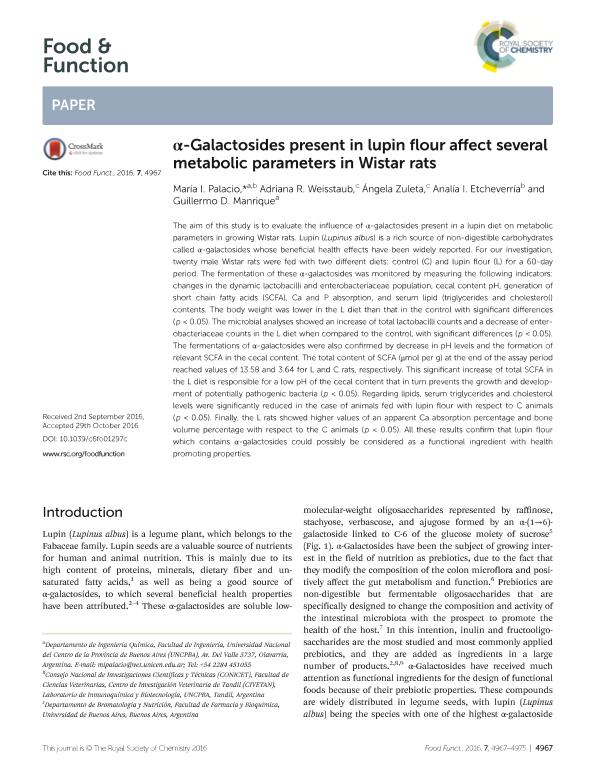Mostrar el registro sencillo del ítem
dc.contributor.author
Palacio, Maria Ines

dc.contributor.author
Weisstaub, Adriana Ruth

dc.contributor.author
Zuleta, Angela

dc.contributor.author
Etcheverría, Analía Inés

dc.contributor.author
Manrique, Guillermo Daniel

dc.date.available
2018-09-05T20:13:26Z
dc.date.issued
2016-12
dc.identifier.citation
Palacio, Maria Ines; Weisstaub, Adriana Ruth; Zuleta, Angela; Etcheverría, Analía Inés; Manrique, Guillermo Daniel; α-Galactosides present in lupin flour affect several metabolic parameters in Wistar rats; Royal Society of Chemistry; Food and Function; 7; 12; 12-2016; 4967-4975
dc.identifier.issn
2042-650X
dc.identifier.uri
http://hdl.handle.net/11336/58434
dc.description.abstract
The aim of this study is to evaluate the influence of α-galactosides present in a lupin diet on metabolic parameters in growing Wistar rats. Lupin (Lupinus albus) is a rich source of non-digestible carbohydrates called α-galactosides whose beneficial health effects have been widely reported. For our investigation, twenty male Wistar rats were fed with two different diets: control (C) and lupin flour (L) for a 60-day period. The fermentation of these α-galactosides was monitored by measuring the following indicators: changes in the dynamic lactobacilli and enterobacteriaceae population, cecal content pH, generation of short chain fatty acids (SCFA), Ca and P absorption, and serum lipid (triglycerides and cholesterol) contents. The body weight was lower in the L diet than that in the control with significant differences (p < 0.05). The microbial analyses showed an increase of total lactobacilli counts and a decrease of enterobacteriaceae counts in the L diet when compared to the control, with significant differences (p < 0.05). The fermentations of α-galactosides were also confirmed by decrease in pH levels and the formation of relevant SCFA in the cecal content. The total content of SCFA (μmol per g) at the end of the assay period reached values of 13.58 and 3.64 for L and C rats, respectively. This significant increase of total SCFA in the L diet is responsible for a low pH of the cecal content that in turn prevents the growth and development of potentially pathogenic bacteria (p < 0.05). Regarding lipids, serum triglycerides and cholesterol levels were significantly reduced in the case of animals fed with lupin flour with respect to C animals (p < 0.05). Finally, the L rats showed higher values of an apparent Ca absorption percentage and bone volume percentage with respect to the C animals (p < 0.05). All these results confirm that lupin flour which contains α-galactosides could possibly be considered as a functional ingredient with health promoting properties.
dc.format
application/pdf
dc.language.iso
eng
dc.publisher
Royal Society of Chemistry

dc.rights
info:eu-repo/semantics/openAccess
dc.rights.uri
https://creativecommons.org/licenses/by-nc-sa/2.5/ar/
dc.subject
Galactosides
dc.subject
Lupin
dc.subject
Metabolic
dc.subject
Rats
dc.subject.classification
Otras Biotecnología Agropecuaria

dc.subject.classification
Biotecnología Agropecuaria

dc.subject.classification
CIENCIAS AGRÍCOLAS

dc.title
α-Galactosides present in lupin flour affect several metabolic parameters in Wistar rats
dc.type
info:eu-repo/semantics/article
dc.type
info:ar-repo/semantics/artículo
dc.type
info:eu-repo/semantics/publishedVersion
dc.date.updated
2018-09-05T15:51:23Z
dc.journal.volume
7
dc.journal.number
12
dc.journal.pagination
4967-4975
dc.journal.pais
Reino Unido

dc.description.fil
Fil: Palacio, Maria Ines. Consejo Nacional de Investigaciones Científicas y Técnicas. Centro Científico Tecnológico Conicet - Tandil. Centro de Investigación Veterinaria de Tandil. Universidad Nacional del Centro de la Provincia de Buenos Aires. Centro de Investigación Veterinaria de Tandil. Provincia de Buenos Aires. Gobernación. Comision de Investigaciones Científicas. Centro de Investigación Veterinaria de Tandil; Argentina. Universidad Nacional del Centro de la Provincia de Buenos Aires. Facultad de Ingenieria Olavarria. Departamento de Ingenieria Quimica; Argentina
dc.description.fil
Fil: Weisstaub, Adriana Ruth. Universidad de Buenos Aires. Facultad de Farmacia y Bioquímica. Departamento de Bromatología y Nutrición Experimental; Argentina
dc.description.fil
Fil: Zuleta, Angela. Universidad de Buenos Aires. Facultad de Farmacia y Bioquímica. Departamento de Bromatología y Nutrición Experimental; Argentina
dc.description.fil
Fil: Etcheverría, Analía Inés. Consejo Nacional de Investigaciones Científicas y Técnicas. Centro Científico Tecnológico Conicet - Tandil. Centro de Investigación Veterinaria de Tandil. Universidad Nacional del Centro de la Provincia de Buenos Aires. Centro de Investigación Veterinaria de Tandil. Provincia de Buenos Aires. Gobernación. Comision de Investigaciones Científicas. Centro de Investigación Veterinaria de Tandil; Argentina
dc.description.fil
Fil: Manrique, Guillermo Daniel. Universidad Nacional del Centro de la Provincia de Buenos Aires. Facultad de Ingenieria Olavarria. Departamento de Ingenieria Quimica; Argentina
dc.journal.title
Food and Function
dc.relation.alternativeid
info:eu-repo/semantics/altIdentifier/doi/http://dx.doi.org/10.1039/C6FO01297C
dc.relation.alternativeid
info:eu-repo/semantics/altIdentifier/url/http://pubs.rsc.org/en/Content/ArticleLanding/2016/FO/C6FO01297C
Archivos asociados
